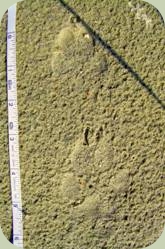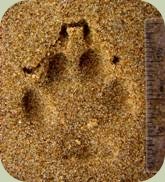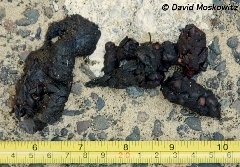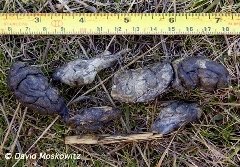Fox Tracks and Sign
An Online Field Guide
Fox tracks can be found in many types of habitats throughout North America including deserts, forests, fields, meadows and suburban areas. Foxes have a varied diet which often includes fruit, berries, insects, crustaceans, small mammals, and birds. There are five species of foxes in North America: the arctic fox, gray fox, red fox, swift fox, and kit fox. The red fox (Vulpes vulpes) and gray fox (Urocyon cinereoargenteus) are the most common foxes in North America.
Fox Tracks

Tracks: Like the tracks of many wild canines, fox footprints tend to be oval in overall shape. They have 4 toes with a generally triangular shape. Each claw on a fox's foot generally registers directly in front of each toe. In some substrates the claws might not register clearly or be hard to see.
For red foxes, the details of the toes may be obscured since their feet are very furry and their toe pads are small. A distinct chevron-shaped pad across the foot pad helps to identify this species. Red fox footprints are generally measure 1.75 to 2.5 inches long by 1.5 to 2" wide (pictured to the right).

For gray foxes, the tracks often show toes more clearly as their feet are less furry than a red fox. Gray foxes can also retract their claws. When retracted, no claw marks register in the tracks. Their tracks fall into a smaller size range, measuring approximately 1.25 to 1.75 inches long by 1 to 1.75 inches wide (pictured to the right).
Gaits: Foxes travel in a variety of gaits, depending on their behavior, location, and substrate. Common gaits include walks, trots, lopes, and gallops. Both gray and red foxes frequently travel in a direct register trot, where the rear foot lands squarely on top of where the front foot had stepped. Gray foxes are capable climbers and often sleep in trees. Both red and gray foxes are very agile and can walk on top of stone walls and logs. Pictured below are the tracks of a gray fox galloping.

Fox Sign
Scat: Like the scat of many canines, fox scat often has a ropey, tapered, and partly segmented shape. Fresh red fox scat often has a distinct musky scent. Fox scat typically does not have the offensive odor common to domestic dog scat. Fox scats are generally 3/8 to 5/8 inches in diameter and 3 to 6 inches long.

Gray Fox Scat

Red Fox Scat
Be More Prepared For Your Next Outdoor Adventure!

Don't leave without knowing these six essential survival skills. Our free survival mini guide reveals the strategies of:
- Shelter & fire to prevent the number one cause of death
- Obtaining clean water to avoid life-threatening dehydration
- Common wild survival foods and other critical skills!

Similar Tracks: Coyote and domestic dogs tracks can be mistaken as fox footprints. Visit the Coyote Tracks and Sign web page to learn more.
References: Elbroch 2003, Halfpenny 1999, Murie 1954, Rezendes 1999. Fox scat photos courtesy David Moskowitz.
Additional Resources:
Red Fox Tracks - Bear Tracker's Pages
Gray Fox Footprints - Bear Tracker's Pages
Learn about Alderleaf's Wildlife Tracking Courses
By the way, when you're out tracking or looking for wild animals, it's important to know how to stay safe in the outdoors, especially if you were to get lost. Right now you can get a free copy of our mini survival guide here, where you'll discover six key strategies for outdoor emergencies, plus often-overlooked survival tips.

About the Author: Filip Tkaczyk is a periodic guest teacher at Alderleaf. He also wrote the field guide Tracks & Sign of Reptiles & Amphibians. Learn more about Filip Tkaczyk.

Return from Fox Footprints back to Wildlife Tracking Articles
Is The Essential Wilderness Survival Skills Course Right for You? Take the "Online Survival Training Readiness" Quiz
See for yourself if this eye-opening course is a good fit for you. It takes just a few minutes! Get your Survival Training Readiness Score Now!

Grow Your Outdoor Skills! Get monthly updates on new wilderness skills, upcoming courses, and special opportunities. Join the free Alderleaf eNews and as a welcome gift you'll get a copy of our Mini Survival Guide.

 The Six Keys to Survival: Get a free copy of our survival mini-guide and monthly tips!
The Six Keys to Survival: Get a free copy of our survival mini-guide and monthly tips!
Learn more